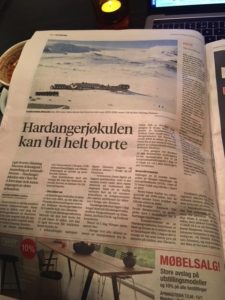
Henning Åkesson successfully defended his thesis ”Deglaciation of the Norwegian fjords” 9th of January 2018 at the University of Bergen. Henning is closely affiliated to the ice2ice project and has combined ice flow models with geological and paleoclimatic data to study the dynamics and response to climate of marine outlet glaciers and ice caps in western Norway and Greenland. Henning’s supervisors have been Kerim H. Nisancioglu, John Inge Svendsen (UiB) and Mathieu Morlighem (Univ. California, Irvine), and his thesis consists of five papers; one already published, three in review and one to be submitted.
The new doctor has already got a new job. He will continue his academic career as a postdoc at Stockholm University, modelling Greenland outlet glaciers of the past.
The main scope of the thesis was to study the behaviour of the western Scandinavian Ice Sheet during the last deglaciation. Henning also co-authored a paper on changes to Jakobshavn Isbræ since the Little Ice Age, West Greenland, as well as lead a paper on Holocene evolution of an ice cap in southern Norway.
In his first paper, Henning and co-authors studies dynamics and sensitivity to climate change of the Hardangerjøkulen ice cap in southern Norway. They use the numerical ice flow model ISSM constrained by glacier and climate reconstructions to simulate ice cap evolution since the mid-Holocene. Here, they find that Hardangerjøkulen grows non-linearly since ice cap inception and that present-day Hardangerjøkulen is exceptionally sensitive to climate change. The latter is related to a flat surface topography and an associated effective surface mass balance-elevation feedback. Read the full paper here.
The second paper shows that fjord width strongly controls the stability of marine-terminating glaciers. Henning and co-authors use an ice flow model purpose-built for fast-flowing outlet glaciers on a suite of idealised fjord geometries, representative of real-world glaciers. They show that identical warming ocean conditions may cause grounding line retreat varying by several tens of kilometers depending on the fjord geometry. The paper is in review.
The third paper gives a decadal to centennial scale perspective of the abrupt retreat of Hardangerfjorden glacier in western Norway at the Younger Dryas–Holocene transition. This well-dated paleoglacier is an excellent past analogue of Jakobshavn Isbræ in Greenland (Paper 4), and other similar outlet glaciers in Greenland, Alaska, and Patagonia. Using the ice flow model from Paper 2 they find that high surface melt and warmer fjord waters are likely triggers and drivers of the reconstructed fast retreat. The study suggests a highly variable retreat history paced by fjord bathymetry and ice tongue buttressing. Periods of high retreat rates contribute significantly to the overall length of retreat, yet these rates are not sustainable for more than a few decades. The paper is to be submitted.
The fourth paper studies the fastest flowing glacier in the world; Jakobshavn Isbræ in western Greenland. This glacier’s floating tongue suddenly collapsed in the early 2000s, with a fast retreat and tripling in speed occurring since. Nonetheless, it is unclear to what extent Jakobshavn’s past history influences its modern retreat. Henning is a co-author on this study, which simulates the history of Jakobshavn since its Little Ice Age (LIA) maximum position in year 1850. The authors find that the glacier responds non-linearly to a linear strengthening in external forcing. The changing forcing following the LIA triggers retreat, while fjord geometry controls the variability of the modelled non-linear retreat history. Because of intermittent grounding line stillstands at geometric pinning points, retreat may be delayed by several decades, only to be followed by an abrupt grounding line migration without additional forcing.
In the fifth paper, Henning and co-authors use the ice flow model ISSM to study deglaciation of the fjords at the Norwegian west coast. Using a first-order climatology based on paleo-records, they suggest that a warming ocean is a highly potent trigger for swift decadal scale grounding line retreat. However, the study finds that multi-millennial deglaciation in this region was driven by surface melt. In addition, the authors find that topography heavily controls the sensitivity marine ice sheet margins; glaciers in fjords with bottleneck inlets and/or shallow sills were significantly more resilient to ocean warming, while wide and deep troughs allow for extensive retreat.
Combined, Henning’s thesis shows that the topography of the landscape itself is fundamental to the sensitivity of glaciers terminating in fjords. His results also suggest that ocean warming and grounding line dynamics are important controls of marine-based retreat over time scales up to a century or two. Beyond these time scales, the atmosphere is found to be the most important driver of ice sheet mass loss.

Henning’s findings on the retreating Norwegian glaciers and likely disappearance within this century, if carbon emissions are left unabated, caught the attention of several broadcasters.
- The local newspaper Bergens Tidende had a one pager where they present and discuss his work and the consequences for people and society. You can read the article here.
- NRK produced this article about the possible dissapreance of the Hardangerjøkelen glacier within a few decades.
- Henning also talked about the demise of Norwegian glaciers as a guest in studio at the news channel TV2 Nyhetskanalen. This was broadcasted live on Saturday 13th of January 2018.